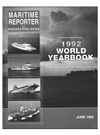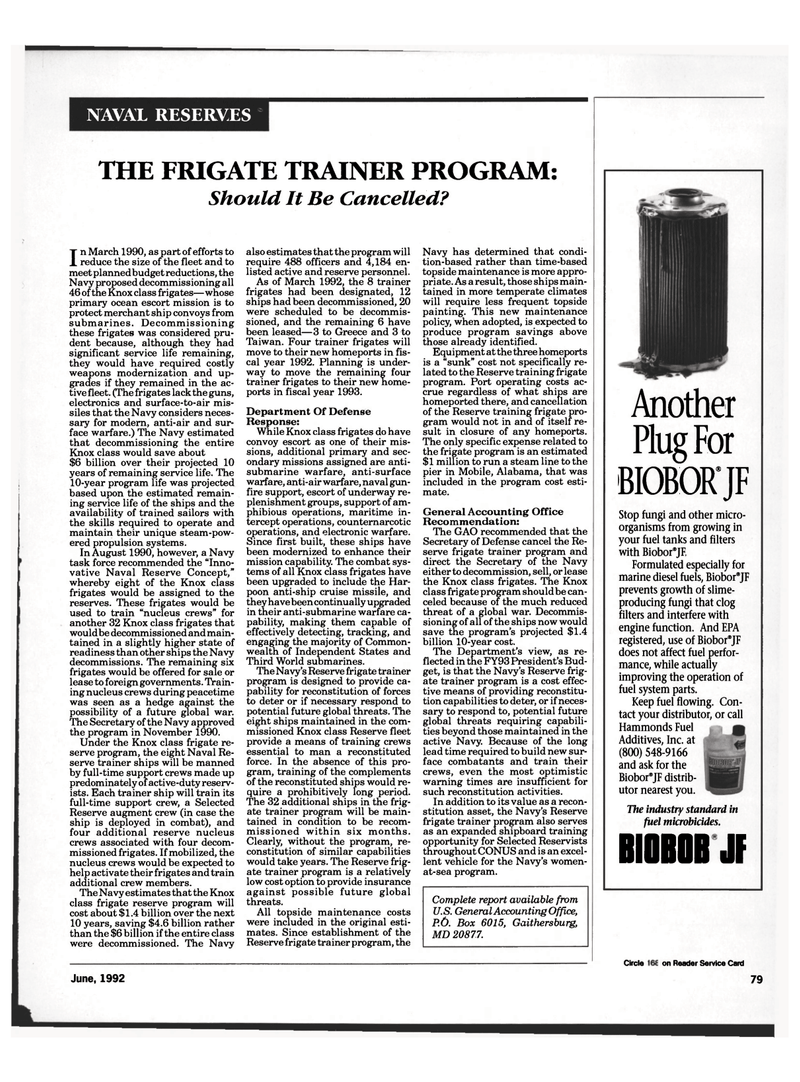
Page 69: of Maritime Reporter Magazine (June 1992)
Read this page in Pdf, Flash or Html5 edition of June 1992 Maritime Reporter Magazine
NAVAL RESERVES
THE FRIGATE TRAINER PROGRAM:
Should It Be Cancelled?
In March 1990, as part of efforts to reduce the size of the fleet and to meet planned budget reductions, the
Navy proposed decommissioning all 46 of the Knox class frigates—whose primary ocean escort mission is to protect merchant ship convoys from submarines. Decommissioning these frigates was considered pru- dent because, although they had significant service life remaining, they would have required costly weapons modernization and up- grades if they remained in the ac- tive fleet. (The frigates lack the guns, electronics and surface-to-air mis- siles that the Navy considers neces- sary for modern, anti-air and sur- face warfare.) The Navy estimated that decommissioning the entire
Knox class would save about $6 billion over their projected 10 years of remaining service life. The 10-year program life was projected based upon the estimated remain- ing service life of the ships and the availability of trained sailors with the skills required to operate and maintain their unique steam-pow- ered propulsion systems.
In August 1990, however, a Navy task force recommended the "Inno- vative Naval Reserve Concept," whereby eight of the Knox class frigates would be assigned to the reserves. These frigates would be used to train "nucleus crews" for another 32 Knox class frigates that would be decommissioned and main- tained in a slightly higher state of readiness than other ships the Navy decommissions. The remaining six frigates would be offered for sale or lease to foreign governments. Train- ing nucleus crews during peacetime was seen as a hedge against the possibility of a future global war.
The Secretary of the Navy approved the program in November 1990.
Under the Knox class frigate re- serve program, the eight Naval Re- serve trainer ships will be manned by full-time support crews made up predominately of active-duty reserv- ists. Each trainer ship will train its full-time support crew, a Selected
Reserve augment crew (in case the ship is deployed in combat), and four additional reserve nucleus crews associated with four decom- missioned frigates. If mobilized, the nucleus crews would be expected to help activate their frigates and train additional crew members.
The Navy estimates that the Knox class frigate reserve program will cost about $1.4 billion over the next 10 years, saving $4.6 billion rather than the $6 billion if the entire class were decommissioned. The Navy also estimates that the program will require 488 officers and 4,184 en- listed active and reserve personnel.
As of March 1992, the 8 trainer frigates had been designated, 12 ships had been decommissioned, 20 were scheduled to be decommis- sioned, and the remaining 6 have been leased—3 to Greece and 3 to
Taiwan. Four trainer frigates will move to their new homeports in fis- cal year 1992. Planning is under- way to move the remaining four trainer frigates to their new home- ports in fiscal year 1993.
Department Of Defense
Response:
While Knox class frigates do have convoy escort as one of their mis- sions, additional primary and sec- ondary missions assigned are anti- submarine warfare, anti-surface warfare, anti-air warfare, naval gun- fire support, escort of underway re- plenishment groups, support of am- phibious operations, maritime in- tercept operations, counternarcotic operations, and electronic warfare.
Since first built, these ships have been modernized to enhance their mission capability. The combat sys- tems of all Knox class frigates have been upgraded to include the Har- poon anti-ship cruise missile, and they have been continually upgraded in their anti-submarine warfare ca- pability, making them capable of effectively detecting, tracking, and engaging the majority of Common- wealth of Independent States and
Third World submarines.
The Navy's Reserve frigate trainer program is designed to provide ca- pability for reconstitution of forces to deter or if necessary respond to potential future global threats. The eight ships maintained in the com- missioned Knox class Reserve fleet provide a means of training crews essential to man a reconstituted force. In the absence of this pro- gram, training of the complements of the reconstituted ships would re- quire a prohibitively long period.
The 32 additional ships in the frig- ate trainer program will be main- tained in condition to be recom- missioned within six months.
Clearly, without the program, re- constitution of similar capabilities would take years. The Reserve frig- ate trainer program is a relatively low cost option to provide insurance against possible future global threats.
All topside maintenance costs were included in the original esti- mates. Since establishment of the
Reserve frigate trainer program, the
Navy has determined that condi- tion-based rather than time-based topside maintenance is more appro- priate. As a result, those ships main- tained in more temperate climates will require less frequent topside painting. This new maintenance policy, when adopted, is expected to produce program savings above those already identified.
Equipment at the three homeports is a "sunk" cost not specifically re- lated to the Reserve training frigate program. Port operating costs ac- crue regardless of what ships are homeported there, and cancellation of the Reserve training frigate pro- gram would not in and of itself re- sult in closure of any homeports.
The only specific expense related to the frigate program is an estimated $1 million to run a steam line to the pier in Mobile, Alabama, that was included in the program cost esti- mate.
General Accounting Office
Recommendation:
The GAO recommended that the
Secretary of Defense cancel the Re- serve frigate trainer program and direct the Secretary of the Navy either to decommission, sell, or lease the Knox class frigates. The Knox class frigate program should be can- celed because of the much reduced threat of a global war. Decommis- sioning of all of the ships now would save the program's projected $1.4 billion 10-year cost.
The Department's view, as re- flected in the FY93 President's Bud- get, is that the Navy's Reserve frig- ate trainer program is a cost effec- tive means of providing reconstitu- tion capabilities to deter, or if neces- sary to respond to, potential future global threats requiring capabili- ties beyond those maintained in the active Navy. Because of the long lead time required to build new sur- face combatants and train their crews, even the most optimistic warning times are insufficient for such reconstitution activities.
In addition to its value as a recon- stitution asset, the Navy's Reserve frigate trainer program also serves as an expanded shipboard training opportunity for Selected Reservists throughout CONUS and is an excel- lent vehicle for the Navy's women- at-sea program.
Complete report available from
U.S. General Accounting Office,
P.O. Box 6015, Gaithersburg,
MD 20877.
Another
Plug For
BIOBOR'JF
Stop fungi and other micro- organisms from growing in your fuel tanks and filters with Biobor®JF.
Formulated especially for marine diesel fuels, Biobor®JF prevents growth of slime- producing fungi that clog filters and interfere with engine function. And EPA registered, use of Biobor®JF does not affect fuel perfor- mance, while actually improving the operation of fuel system parts.
Keep fuel flowing. Con- tact your distributor, or call
Hammonds Fuel
Additives, Inc. at (800) 548-9166 and ask for the
Biobor®JF distrib- utor nearest you.
The industry standard in fuel microbicides.
BIOBOBJf
June, 1992
Circle 237 on Reader Service Card 79

 68
68

 70
70
